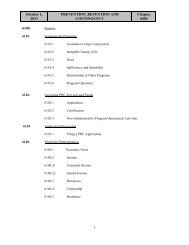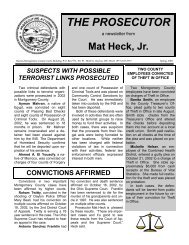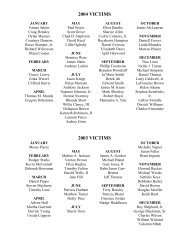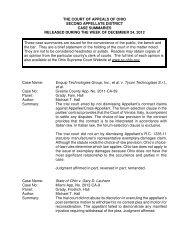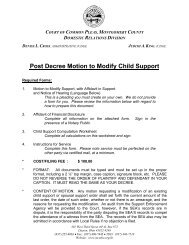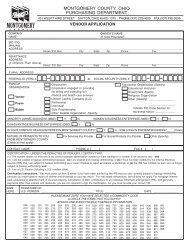THE COURT OF APPEALS OF OHIO SECOND APPELLATE ...
THE COURT OF APPEALS OF OHIO SECOND APPELLATE ...
THE COURT OF APPEALS OF OHIO SECOND APPELLATE ...
Create successful ePaper yourself
Turn your PDF publications into a flip-book with our unique Google optimized e-Paper software.
Case Name: State of Ohio v. Samuel J. Atkins<br />
Case No.: Miami App. No. 2011 CA 28<br />
Panel: Donovan, Hall, Vukovich<br />
Author: Mary E. Donovan<br />
Summary: Trial court erred when it found that the police who were involved in the<br />
high speed chase and eventual capture of appellant were “victims” for<br />
the purpose of finding him ineligible for ILC pursuant to R.C.<br />
2951.041(B)(7). Nevertheless, the error is harmless since the trial<br />
court, in the exercise of its discretion, found that ILC would demean<br />
the seriousness of the offense pursuant to R.C. 2951.041(B)(6) as<br />
this was a multi-county chase with speeds in excess of 100 m.p.h.<br />
Judgment affirmed.<br />
Case Name: State of Ohio v. Deirdre Nichols<br />
Case No.: Montgomery App. No. 25056<br />
Panel: Grady, Fain, Donovan<br />
Author: Mary E. Donovan<br />
Summary: Record reveals no arguably meritorious issues for appellate review.<br />
[Anders brief]. Judgment affirmed.<br />
Case Name: State of Ohio v. Michael A. Nabors<br />
Case No.: Montgomery App. No. 24582<br />
Panel: Grady, Fain, Donovan<br />
Author: Mary E. Donovan<br />
Summary: The trial court did not err in overruling Appellant’s motion to suppress,<br />
since the State established that Appellant’s consent to provide a<br />
saliva sample for DNA testing was freely and voluntarily given.<br />
Appellant was not in custody when interviewed, the investigating<br />
officer was not required to administer Miranda warnings, and<br />
ineffective assistance of counsel is not demonstrated where defense<br />
counsel withdrew the branch of the motion to suppress directed to<br />
Appellant’s statements, if any. Judgment affirmed.<br />
Case Name: State of Ohio v. Christopher D. Henry<br />
Case No: Montgomery App. No. 25007<br />
Panel: Grady, Fain, Donovan<br />
Author: Mike Fain<br />
Summary: Placing a GPS tracking device on the underneath of a car to track a<br />
suspect’s movements, without a warrant, violates the Fourth<br />
Amendment, and evidence obtained as a result is subject to<br />
exclusion. United States v. Jones, 565 U.S. ____, 132 S.Ct. 945, 181<br />
L.Ed.2d 911 (2012), followed.<br />
The State relied upon Davis v. United States, ____ U.S. ____, 131<br />
S.Ct. 2419, 180 L.Ed.2d 285 (2011), for proposition that police<br />
officer’s placing GPS tracking device was in objectively reasonable<br />
reliance upon non-binding judicial authorities, thereby triggering goodfaith<br />
exception to exclusionary rule. This reliance is misplaced, in<br />
. . . . . . . . . . . . . . . . . . . . . . . . . . . . . . . Court of Appeals Case Summary, October 12, 2012 Page 2



